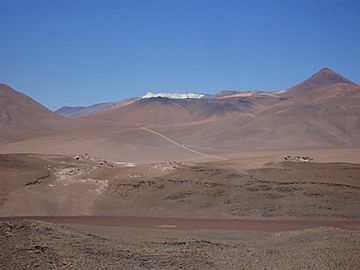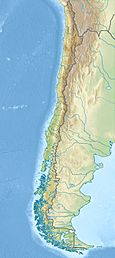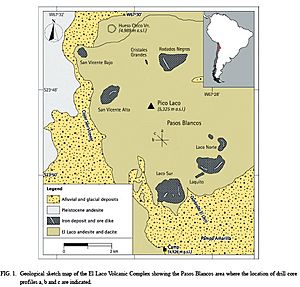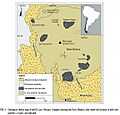El Laco facts for kids
Quick facts for kids El Laco |
|
|---|---|

The conical summit to the right is named Pico El Laco. The black zones to the left of it are Cerro Laco Sur and Cerro Laco Norte. The image shows only about half of the volcanic complex.
|
|
| Highest point | |
| Elevation | 5,325 m (17,470 ft) |
| Geography | |
El Laco is a group of volcanoes in the Antofagasta Region of Chile. It is located in the Andes mountains. This area is known as the Central Volcanic Zone.
El Laco is made up of seven different stratovolcanoes and a large bowl-shaped caldera. It started forming about two million years ago. The highest point of the volcano is a lava dome called Pico Laco. It is about 5,325 metres (17,470 ft) (or 5,472 metres (17,953 ft)) high.
Over time, glaciers have shaped the volcano. Some people believe that El Laco is still active, with fumaroles (gas vents) releasing steam.
This volcano is famous for its unique lava flows. These flows contain a lot of magnetite, which is a type of iron ore. Scientists are still trying to understand exactly how these special iron-rich lavas formed.
Since they were discovered in 1958, these iron deposits have been mined. Similar volcanic iron deposits can be found in other parts of the world, like Australia and Iran.
Contents
Where is El Laco located?
El Laco is part of a larger group of volcanoes called the Cordón de Puntas Negras. It sits on top of ancient rock layers. These layers were once at the bottom of the sea.
The city of Antofagasta is about 320 kilometres (200 mi) west of El Laco. Other nearby towns include Calama and San Pedro de Atacama. An international road that connects Salta in Argentina with Calama in Chile passes close to El Laco.
The area around El Laco is part of the Atacama Desert. This desert is very dry, which makes it a great place for astronomy observatories. Many tourist spots are also found in this region.
How did El Laco form?
The El Laco volcano complex has about seven smaller stratovolcanoes and lava domes. It began to form millions of years ago.
First, during the Miocene and Pliocene periods, andesite lava created a stratovolcano. Later, ash and rock fragments erupted, forming a large caldera about 4–5 kilometres (2.5–3.1 mi) wide. A central lava dome then grew inside this caldera.
Much later, probably during the Pleistocene Ice Age, five special iron-rich lava flows came out. These flows are known as Laco Sur, Laco Norte, and Rodados Negros. Two other iron-rich structures, Laquito and Cristales Grandes, also formed then.
The main peak, Pico Laco, is an andesitic lava dome. It rises about 400 metres (1,300 ft) above the land around it. It has two summits, with the eastern one being the highest.
Other peaks include Hueso Chico, a cone about 120 metres (390 ft) tall. Another peak, "Volcano 5009", is very old and worn down. Its activity might have happened at the same time as glaciers were present.
Scientists have used different methods to figure out the age of the rocks at El Laco. The oldest rocks are about 5.3 million years old. Some parts of Pico Laco are about 3.9 million years old. The youngest rocks found are about 1.6 million years old.
Even after the iron deposits formed, volcanic activity continued. Over time, water and glaciers also changed the volcano's shape. There are still reports of fumarolic activity and hot springs in the area.
What are the iron deposits?
On the sides of the volcano, between 4,600–5,200 metres (15,100–17,100 ft) high, you can find deposits of apatite, hematite, and magnetite. El Laco is mostly known for these unique iron-rich lava flows. This material is also found as tephra (volcanic ash and rock fragments).
These deposits sit on top of older lava flows. They are found in a circle around Pico Laco. The main deposits are called Laco Norte, Laco Sur, San Vicente Alto, San Vicente Bajo, and Rodados Negros.
These iron deposits include dykes (rock intrusions), hydrothermal deposits, lava flows, and volcanic ash. The magnetite is like a type of rock called porphyry. Apatite is a common mineral found in these lavas.
The iron-rich rocks include lava flows, ash, and small volcanic rocks called lapilli. The magnetite lava flows at El Laco are very rare. They formed when Earth's plates were pushing together.
Types of iron deposits
Laco Norte is the biggest iron deposit. It is about 60–90 metres (200–300 ft) thick and covers a large area. It looks like a flat-topped hill or mesa. At Laco Norte, you can see five layers of rock, including magnetite lava and iron-rich ash.
Laco Sur is similar in shape and size. It has been mined for its iron. San Vicente Alto is a lava flow higher up on the volcano. San Vicente Bajo is probably a lava dome.
Laquito and Rodados Negros seem to be dykes (rock intrusions). Cristales Grandes is more like a vein, showing signs of being formed by hot water. A large amount of magnetite is also thought to be hidden underground near the volcano.
How do the iron lavas look?
The magnetite lavas often look like rough, jagged aa lava. But they also have smooth, ropy pahoehoe features. Sometimes, the magnetite forms tall, pillar-like shapes. This means it cooled very quickly. This columnar magnetite has only been found in one other place in the world, in Sweden.
The lava flows have holes and tubes formed by escaping volcanic gas. These holes are lined with magnetite crystals. Before and after the magnetite lavas, layers of iron-rich volcanic ash also erupted. The magnetite lava flows are about 50 metres (160 ft) thick.
The ash-like deposits are porous and easily broken. They show layers, like sediments. Some of the ash at Laco Sur contains small spheres of magnetite. The iron ores are about 2.1 million years old.
How did the iron deposits form?
Scientists have different ideas about how these unique iron-rich rocks formed. Some believe they came directly from magma (molten rock) deep inside the Earth. They think that iron-rich liquid separated from other magma. Evidence like magnetite lava "bombs" supports this idea.
Other scientists think that hot water changed existing volcanic rocks into magnetite. A third idea is that magnetite crystals formed in magma and then floated to the surface with gas bubbles. It's also possible that a mix of these processes happened.
Some of the magnetite turned into hematite, probably because of rainwater. This process changed the original iron. The iron-rich magma likely formed in a magma chamber underground. High amounts of phosphorus and other gases might have made the magma melt at a lower temperature. This would have helped it erupt.
Human use of the iron deposits
These iron deposits were first found in 1958. Mining began in the Laco Sur area in the 1970s. About two million tons of magnetite were removed by the 1990s. This left a large open pit.
In 2009, a company called Cia Minera del Pacifico S.A. was mining these reserves. It is thought that the deposit still holds about 733.9 million tons of ore. This ore is about 50% iron.
These types of iron deposits are interesting to geologists. This is because they are often found with other valuable minerals. For example, the Olympic Dam mine in Australia is a similar site.
Other similar iron deposits
The iron deposits at El Laco are similar to the Kiruna magnetites in Sweden. They have similar amounts of manganese and vanadium, and low titanium. Both El Laco and Kiruna are called "Iron oxide-apatite" ore deposits. El Laco is the best preserved and youngest of its kind on Earth.
Other places with volcanic iron ore include the Chilean Iron Belt, Mexico, and Iran.
What are the rocks made of?
The main rocks of El Laco volcano are andesite and dacite. These rocks contain minerals like biotite and pyroxene. They also have small blobs of iron oxide. The iron-rich rocks are a smaller part of the volcano.
The rocks belong to a group called calc-alkaline volcanic rocks. This is similar to rocks from nearby volcanoes like Lascar and Llullaillaco. The andesite rocks contain minerals like plagioclase, clinopyroxene, and orthopyroxene. They also have magnetite crystals.
Magnetite and hematite are the most common iron minerals. Other minerals found include anhydrite, diopside, and pyrite. The magma that erupted was probably rich in gas. This is because magnetite lavas would normally need very high temperatures (over 1,500 °C (2,730 °F)) to melt.
Hot water has changed the central lava dome and the iron deposits. This process created new minerals like alunite, gypsum, kaolinite, and quartz. Some of these minerals form veins inside the rocks. Large areas of the volcano have been changed by hot water at temperatures of 200–250 °C (392–482 °F). This makes the rocks look clear.
What is the environment like?
The plants in the area are mostly low bushland. Short-tailed chinchillas, which are a threatened species, can be found at El Laco. This is one of the few places in Chile where they live.
El Laco has a cold mountain climate. It is on the edge of the dry Altiplano (high plateau) and the very dry Atacama Desert. A nearby weather station recorded an average temperature of 2.3 °C (36.1 °F) in 1991. Most of the rain falls during the southern hemisphere summer. Snowfall has also been recorded in winter. The air humidity in 1991 was usually between 10–30%.
Images for kids
See also
 In Spanish: El Laco para niños
In Spanish: El Laco para niños





